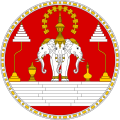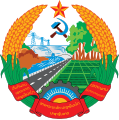| National Emblem of the Lao People's Democratic Republic | |
|---|---|
 | |
| Armiger | Lao People's Democratic Republic |
| Adopted | 1991 |
| Motto | ສັນຕິພາບ ເອກະລາດ ປະຊາທິປະໄຕ "Peace, Independence, Democracy" ເອກະພາບ ວັດຖະນາຖາວອນ "Unity and Prosperity" ສາທາລະນະລັດ ປະຊາທິປະໄຕ ປະຊາຊົນລາວ "Lao People's Democratic Republic" |
| Other elements | A crescent-shaped stalks of fully ripened rice at sides in between the tips of the Pagoda and the red ribbon wrapped around it on sides with the National Motto and the Name of the State. |
The National Emblem of the Lao People's Democratic Republic shows the national shrine Pha That Luang. A dam is pictured, which is a symbol of power generation at the reservoir Nam Ngum. An asphalt street and a stylized watered field is pictured. In the lower part is a section of a gear wheel. The inscription on the left reads "Peace, Independence, Democracy" (Lao script: ສັນຕິພາບ ເອກະລາດ ປະຊາທິປະໄຕ) and on the right, "Unity and Prosperity" (Lao script: ເອກະພາບ ວັດຖະນາຖາວອນ).



